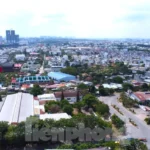This is a historic political event for the country, witnessing a grand restructuring of the nation, not just for better organization but also for stronger development. It marks a turning point in the country’s history, ushering in a new era of growth towards a prosperous, happy, and sustainable Vietnam.
The ceremony in Ho Chi Minh City was graced by General Secretary To Lam, while Chairman of the Presidential Office Luong Cuong attended the ceremony in Hanoi. Prime Minister Pham Minh Chinh was present at the ceremony in Hai Phong, and National Assembly Chair Tran Thanh Man joined the event in Can Tho. Standing member of the Party Central Committee’s Secretariat Tran Cam Tu attended the ceremony in Da Nang. Many other Party and State leaders were also present at the ceremonies across different localities.
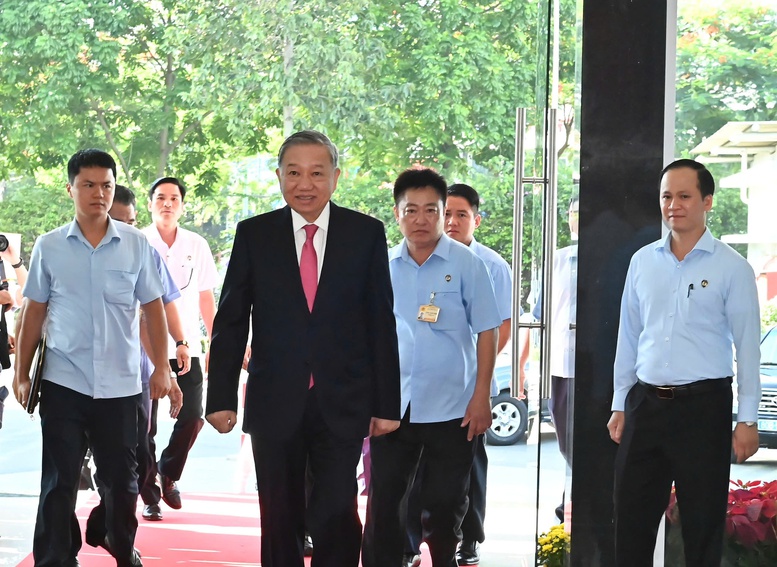
General Secretary To Lam attends the ceremony in Ho Chi Minh City – Photo: SGGP
At the Ho Chi Minh City ceremony, the following leaders were present:
General Secretary To Lam
; Nguyen Minh Triet, former Politburo member and former President; Nguyen Van Nen, Politburo member and Secretary of the Ho Chi Minh City Party Committee; Nguyen Thien Nhan, former Politburo member and former Secretary of the Ho Chi Minh City Party Committee. The ceremony announced the resolutions and decisions of the Central and local authorities regarding the merger of administrative units at the provincial and communal levels, the termination of operations of administrative units at the district level, and the establishment of Party organizations, along with the designation of Party cells, People’s Councils, People’s Committees, Fatherland Front Committees, and other special units.
Also in attendance were Central Committee members and former Central Committee members; leaders and former leaders of Ho Chi Minh City, Binh Duong province, and Ba Ria – Vung Tau province; secretaries of directly subordinate Party committees; and secretaries of Party committees of communal and special units.
The new Ho Chi Minh City is formed by merging the entire natural area and population of Ho Chi Minh City, Ba Ria – Vung Tau, and Binh Duong. Post-restructuring, Ho Chi Minh City spans over 6,722 square kilometers
2
and is home to more than 14 million people.
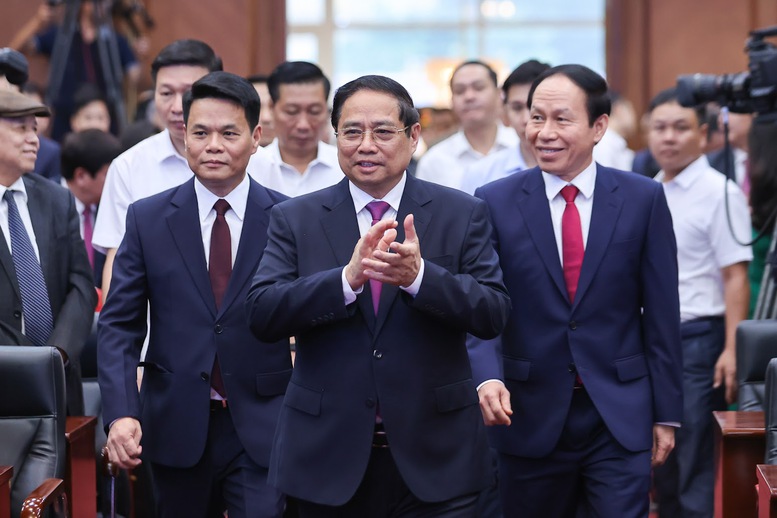
Politburo member and Prime Minister Pham Minh Chinh attends the ceremony in Hai Phong – Photo: VGP/Nhat Bac
Politburo member and Prime Minister Pham Minh Chinh
attended the ceremony announcing the resolutions and decisions of the Central and local authorities in Hai Phong.
The new Hai Phong city is established by rearranging the entire natural area and population of Hai Phong city and Hai Duong province.
The new Hai Phong city covers an area of 3,194.72 square kilometers and has a population of 4,664,124 people. It comprises 114 administrative units at the communal level, including 67 communes, 45 wards, and 2 special units.
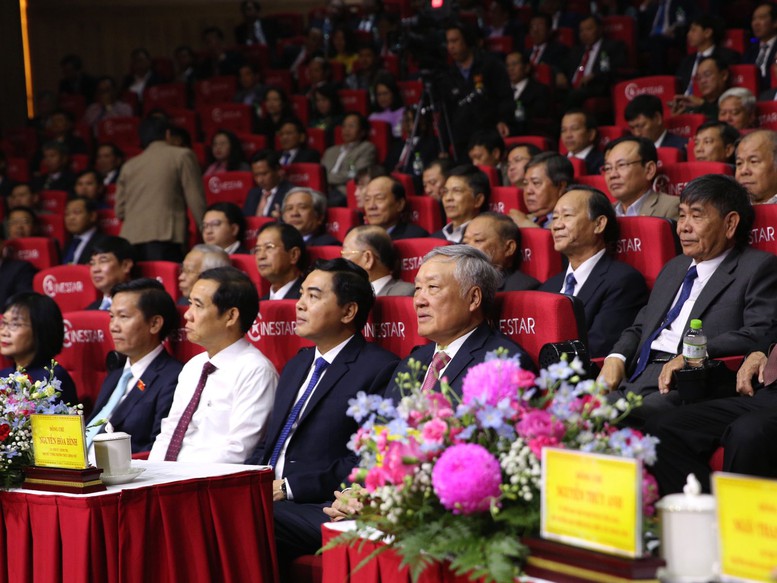
Politburo member and Standing Deputy Prime Minister Nguyen Hoa Binh attends and directs the ceremony in Lam Dong – Photo: VGP/Nguyen Hoang
Politburo member and Standing Deputy Prime Minister Nguyen Hoa Binh
attended and directed the ceremony in Lam Dong.
The new Lam Dong province is formed by rearranging the entire natural area and population of Dak Nong province, Binh Thuan province, and Lam Dong province. Post-restructuring, Lam Dong province spans over 24,233.07 square kilometers and has a population of 3,872,999 people. The province now comprises 124 administrative units at the communal level, including 103 communes, 20 wards, and 1 special unit.
With the merger of Dak Nong and Binh Thuan, the new Lam Dong province becomes the largest province in Vietnam in terms of area. This merger not only expands the province’s scale but also restructures the socio-economic development space of the entire region.
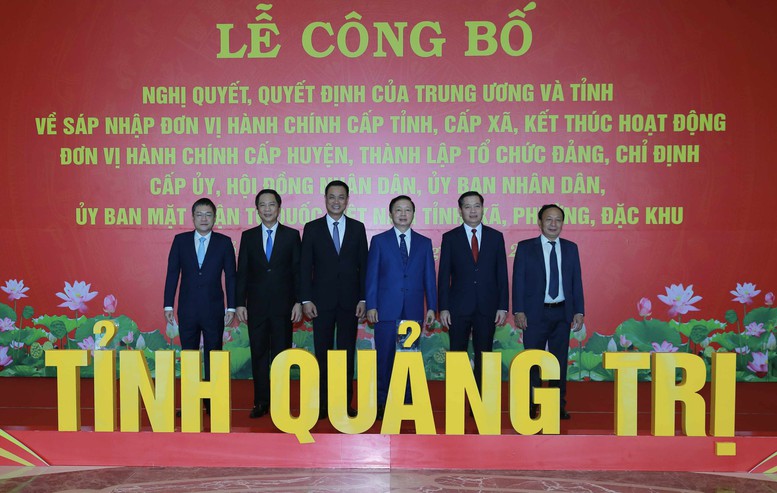
Deputy Prime Minister Tran Hong Ha attends the ceremony in Dong Hoi, Quang Tri – Photo: VGP/Minh Khoi
Deputy Prime Minister Tran Hong Ha
attended and spoke at the ceremony announcing the resolutions and decisions regarding the merger of administrative units and the establishment of Party organizations, along with the designation of Party cells, People’s Councils, People’s Committees, and Fatherland Front Committees of the new Quang Tri province, in Dong Hoi city, Quang Tri province.
Post-merger, Quang Tri province spans over 12,700 square kilometers with a population of nearly 1.85 million people. With its new scale and potential, it is poised to become a comprehensive economic center in North Central Vietnam. Strategically located as a multi-modal gateway for trade, Quang Tri serves as a vital link between the sea and the mainland. The province boasts significant potential for tourism, renewable energy, industry, and high-tech agriculture…
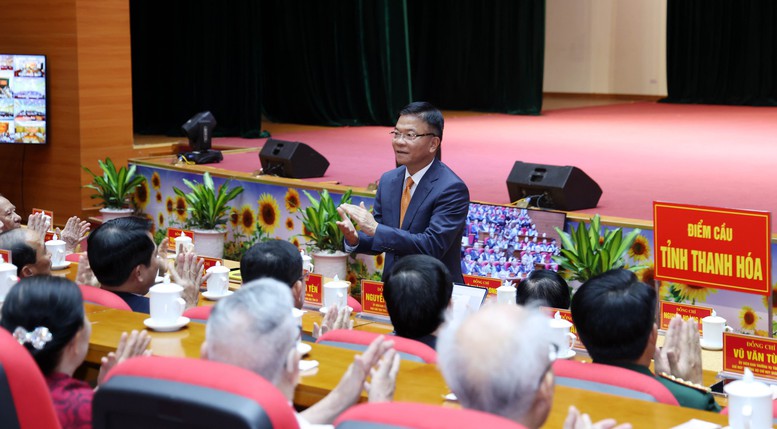
Deputy Prime Minister Le Thanh Long attends the ceremony in Thanh Hoa – Photo: VGP/Duc Tuan
In Thanh Hoa,
Deputy Prime Minister Le Thanh Long
attended the ceremony announcing the resolutions and decisions of the Central and local authorities regarding the restructuring of organizational apparatus and administrative units in Thanh Hoa.
According to the province’s leaders, all necessary conditions regarding infrastructure, equipment, information technology infrastructure, platforms, and applications to serve the people, businesses, and the operations of agencies and units are now in place.
The localities have also developed plans for human resource allocation based on job positions while effectively communicating to the people about the addresses of the centralized public administrative service centers at the communal level and relevant directives of the Central and provincial authorities. Everything is ready for the official operation of the new communes and wards starting July 1, ensuring smoothness and efficiency.
Thanh Hoa province has completed the restructuring and merging of administrative units at the communal level, reducing the number from 529 units (including 435 communes, 63 wards, and 31 towns) to 166 new units (comprising 147 communes and 19 wards). This merger aims to streamline the apparatus, improve management efficiency, and promote socio-economic development in the locality.
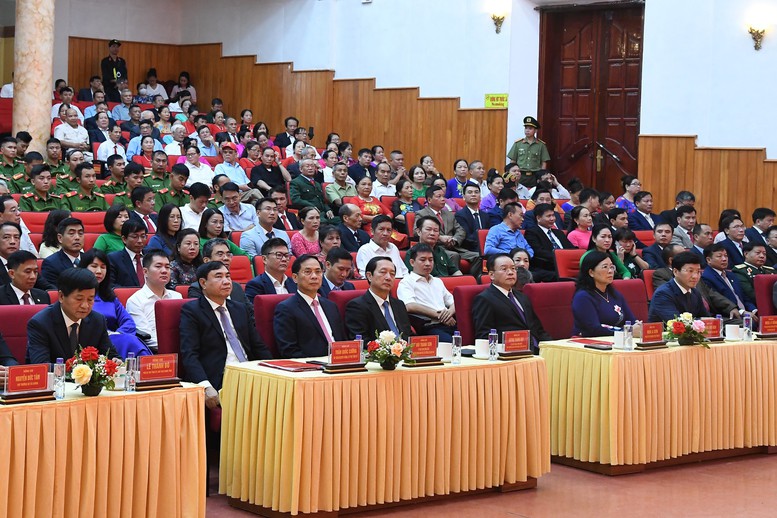
Deputy Prime Minister and Minister of Foreign Affairs Bui Thanh Son, Deputy Head of the Central Committee’s Commission for Information and Education and Head of the Central Committee’s Commission for Mass Mobilization Huynh Thanh Dat, Secretary of the Dien Bien Party Committee Tran Quoc Cuong, and representatives of some Central Committees and ministries attend the ceremony in Dien Bien – Photo: VGP/Hai Minh
At the Dien Bien bridge,
Deputy Prime Minister and Minister of Foreign Affairs Bui Thanh Son
, Deputy Head of the Central Committee’s Commission for Information and Education and Head of the Central Committee’s Commission for Mass Mobilization Huynh Thanh Dat, Secretary of the Dien Bien Party Committee Tran Quoc Cuong, and representatives of some Central Committees and ministries were present at the ceremony.
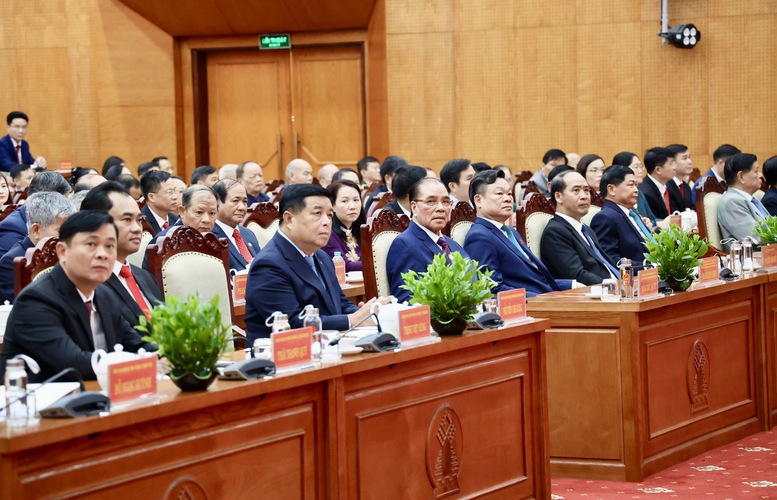
Former Politburo member and former General Secretary Nong Duc Manh; Deputy Prime Minister Nguyen Chi Dung, along with leaders and former leaders of Thai Nguyen and Bac Kan provinces – Photo: VGP/Thu Sa
Deputy Prime Minister Nguyen Chi Dung
attended the ceremony announcing the resolutions and decisions of the Central and local authorities regarding the merger of administrative units at the provincial and communal levels in Thai Nguyen province.
The ceremony in Thai Nguyen was honored by the presence of Nong Duc Manh, former Politburo member and former General Secretary of the Central Committee; representatives of Central Committees and ministries; and leaders and former leaders of Thai Nguyen and Bac Kan provinces from different periods.
Thai Nguyen province covers an area of 3,534 square kilometers with a population of nearly 1.4 million people. Post-restructuring, the number of its administrative units at the communal level decreased from 172 to 55. Bac Kan province, with an area of nearly 4,859 square kilometers and a population of over 326,000 people, now has 37 administrative units at the communal level, down from 108 units.
Post-merger, Thai Nguyen province spans over 8,375.21 square kilometers with a population of approximately 1.8 million people and comprises 92 administrative units at the communal level. The new Thai Nguyen province has strengths in industry (with metallurgy and mechanics, combined with mineral resources, forming a complete production chain), forestry (with a large forest cover, combined with wood and agricultural product processing industries), and tourism (with potential sites that can form an attractive eco-history tourism route).
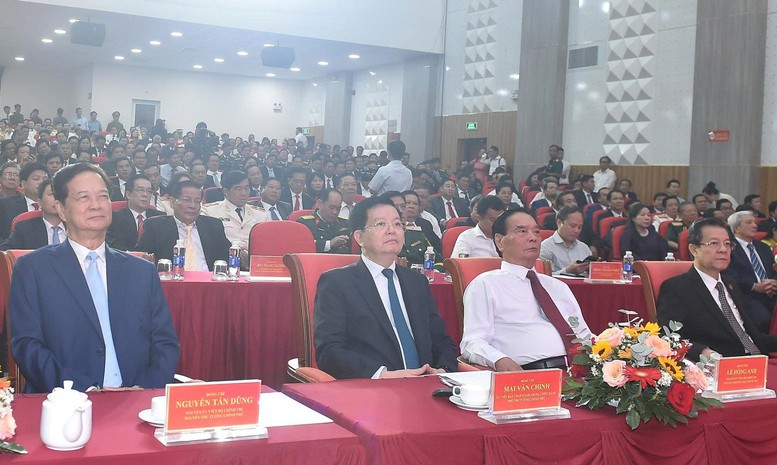
Former Politburo member and former Prime Minister Nguyen Tan Dung; former Politburo member and former Permanent member of the Party Central Committee’s Secretariat Le Hong Anh; Deputy Prime Minister Mai Van Chinh, along with leaders and former leaders of An Giang and Kien Giang provinces attend the ceremony in Kien Giang – Photo: VGP/Giang Thanh
At the Cultural and Artistic Center of An Giang province, Rach Gia ward, An Giang province,
Deputy Prime Minister Mai Van Chinh
attended the ceremony announcing the resolutions and decisions of the Central and local authorities regarding the merger of administrative units at the provincial and communal levels, the termination of operations of administrative units at the district level, and the establishment of Party organizations, along with the designation of Party cells, People’s Councils, People’s Committees, Fatherland Front Committees, and other special units of An Giang province.
Also present at the ceremony were former Politburo member and former Prime Minister Nguyen Tan Dung; former Politburo member and former Permanent member of the Party Central Committee’s Secretariat Le Hong Anh; leaders of Central Committees and ministries; and leaders and former leaders of An Giang and Kien Giang provinces.
More updates to follow…
The Power of Persuasive Writing: Crafting Compelling Headlines
“Bình Dương’s Business Pause: Awaiting the Merge with Ho Chi Minh City”
The transformation of Binh Duong’s urban landscape is underway, with a strategic relocation of businesses from the southern region to the north. Aiming to create a modern and vibrant city with improved living standards and green spaces for its residents, the local government has initiated a plan to rearrange land allocation, count businesses, and calculate support packages. However, due to the impending merger with Ho Chi Minh City, this ambitious project has been temporarily halted.
The Sky’s the Limit: Unveiling the $250 Million Airport Project in Quảng Trị
The Quang Tri Airport Port project is an ambitious undertaking, spanning over 265 hectares across three communes in Gio Linh district. With an investment of 5,800 billion VND, this project promises to be a significant development in the region.


